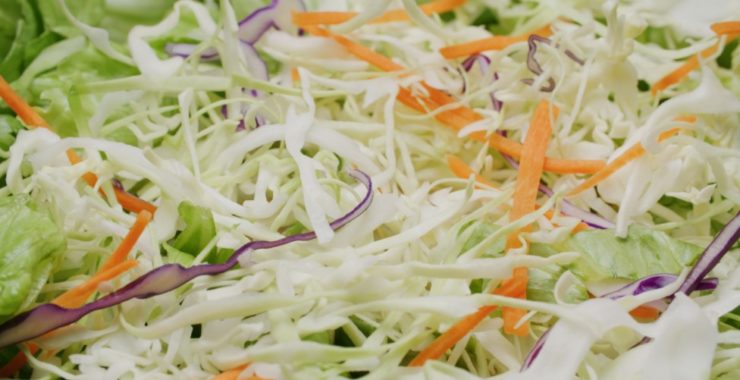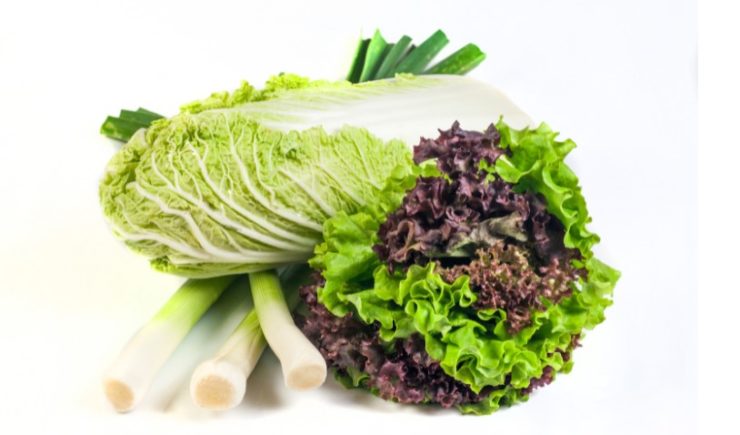Whether you’re preparing to plant a garden or are trying to boost your vegetable consumption, it’s understandable if you’re confused about the differences between lettuce and cabbage. Both plants have similar appearances, but they have distinct properties and uses.
In this guide, we’ll compare lettuce vs cabbage so you can identify them the next time you’re at the grocery store.
In This Article
Appearance
Lettuce comes in several varieties.
However, regardless of the type, they share similar characteristics of having thin leaves that either fold into each other to form a dense lettuce head or grow into a long rosette. The leaves range from light green to deep red color. Some leaves are curly, while others are smooth.
The lettuce plant grows once per season. When it’s in the right conditions, including cooler weather without an excessive amount of sun, it can grow anywhere from 12 to 40 inches tall.
Some of the most common types of lettuce include:
- Butterhead
- Iceberg
- Romaine
- Summer crisp
Whereas lettuce varies significantly in its appearance depending on the type, cabbage always has the same shape. Cabbage has a short stem with a large, round ball that forms the head. Its leaves fold into each other to create a dense structure.
You can purchase cabbage in green, red, and purple varieties. Cabbage prefers similar growing conditions as lettuce, although it can tolerate more sun. Typically, the cooler the climate that cabbage grows in, the stronger its flavor.
You can purchase cabbage in several varieties, including:
- Common green and red
- Savoy’s heads
- Asian cabbage
- Dutch cabbage
Taste & Texture

Taste is a defining difference when comparing lettuce vs cabbage. Cabbage has a 92% water content, whereas lettuce is 96% water. While this difference may not sound like much, it gives the cabbage a tougher texture, which is why it’s unusual to encounter large chunks of cabbage in a salad.
On the other hand, lettuce has a crunchier texture while simultaneously being easier to eat raw.
Neither lettuce nor cabbage has a very attractive taste on its own, which is why people accompany them with salad dressing and sauces.
However, if you eat them raw, you’ll likely notice that lettuce has either a slightly sweet or bitter flavor—the longer lettuce stays in the ground past its peak harvesting time, the more bitter it’ll taste.
In contrast, cabbage typically has a stronger, more intense flavor than lettuce. Most cabbage has a distinctive bitter taste, although some varieties can have a touch of sweetness.
Culinary Uses

Cabbage is a hardy vegetable with a range of culinary uses. Cabbage is in the Brassica genus, which also includes broccoli, Brussel sprouts, and turnips.
Therefore, it may come as little surprise that you can cook cabbage in the following ways:
- Boiling
- Stewing
- Sautéing
- Braising
Of course, you can also eat it raw; cabbage is one of the main ingredients in coleslaw. My personal preference is to toss cabbage in a stock pot as part of a hearty soup.
On the other hand, people primarily eat lettuce in its raw state for salads, sandwiches, and wraps. Due to its delicate skin, it isn’t common to encounter lettuce in cooked foods, although some people use it in soup.
Health Benefits

Lettuce and cabbage are excellent vegetables to include in your diet. Both are low-calorie foods, and because of the higher macronutrient levels in cabbage, it has slightly more calories than lettuce.
Cabbage is high in vitamin C, with a half-cup of the cooked vegetable offering up to 35% of your daily needs. It’s also an excellent source of vitamin K, magnesium, and folate.
In fact, studies suggest that consuming cabbage might protect people from the harmful effects of radiation therapy since it contains 3,3’-diindolylmethane (DIM). It also may help prevent cancer.
On the other hand, the health benefits of lettuce depend on the type you consume. You’ve likely heard that iceberg lettuce doesn’t have nutritional value.
While health experts prove this is a myth, the facts don’t lie—butter lettuce is more nutritious than iceberg lettuce. Furthermore, romaine lettuce is more nutritious than either of them, offering over double the amount of vitamin A and folate.
So, if you want a nutritional boost from your lettuce, choose varieties that have deep green and red colors.
Wrap Up: Lettuce vs Cabbage Summary

Now that you understand the differences between cabbage and lettuce, below is a summary of the traits that they share:
- Multi-layer leaf structure
- Grows best in cool climates
- Good sources of vitamins and minerals
- Color variations within their species
Despite these similarities, lettuce and cabbage have many more differences. They include:
- Lettuce comes in a couple of shapes, and cabbage comes in a single bulb shape
- Cabbage is better for cooking
- Lettuce has a milder taste
- Cabbage has a higher concentration of nutrients
- Lettuce doesn’t store as well as cabbage
We hope you have a greater appreciation for lettuce and cabbage after reading this. Both are distinct but beneficial vegetables to include in your diet.







